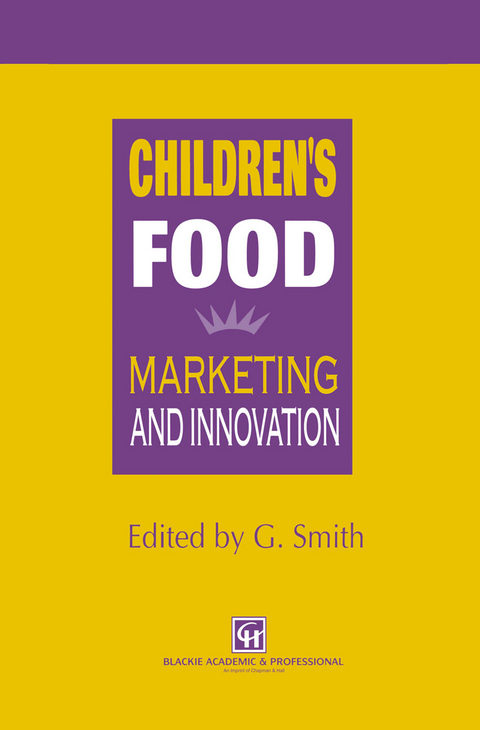Children’s Food
Chapman and Hall (Verlag)
978-0-7514-0274-2 (ISBN)
1 Influences on food choice within the family.- 1.1 Introduction.- 1.2 Why food is so significant.- 1.3 Personal factors in children’s food choice.- 1.4 Social factors in children’s food choices.- 1.5 Concerns about children’s eating.- 1.6 The processes of food choice.- 1.7 Recent research into family food choice.- 1.8 Implications of the research.- 1.9 How advertising can fit into the food choice process.- 1.10 Conclusion.- References.- 2 How to make effective advertising aimed at children.- 2.1 Introduction.- 2.2 Understanding the audience better.- 2.3 Ages and stages.- 2.4 Advertising to children.- 2.5 Enduring themes.- 2.6 Executional elements.- 2.7 Deadly sins.- 2.8 Conclusions.- 3 Starting the day right!.- 3.1 Introduction.- 3.2 Who eats breakfast?.- 3.3 Break the fast!.- 3.4 Compromising diet quality.- 3.5 Breakfast and health status.- 3.6 Mental, academic and physical performance.- 3.7 Does it matter what we eat?.- 3.8 Can breakfast prevent nutritional problems?.- 3.9 Can the breakfast habit prevent future illness?.- 3.10 Start the day right!.- References.- 4 Why tastes change.- 4.1 Introduction.- 4.2 Key changes in society, family and food.- 4.3 The direct influence of children on food.- 4.4 Model for change in children.- 4.5 Conclusion.- Reference.- 5 Children’s nutrition: drivers for change.- 5.1 Introduction.- 5.2 What are children eating today?.- 5.3 Health issues for children’s diets.- 5.4 The role of fat in children’s diets.- 5.5 Carbohydrates: starches and sugars.- 5.6 Fibre.- 5.7 Eating patterns and the nutritional role of snack foods.- 5.8 Vegetable and fruit consumption.- 5.9 The outlook for the future and its product development implications.- References.- 6 The politics of advertising to children.- 6.1 Introduction.- 6.2 Research, publicpolicy and politics.- 6.3 Advertising: the front line.- 6.4 Gullibility.- 6.5 Advertising as education.- 6.6 ‘Pester power’ and parental responsibilities.- 6.7 The Big Hijack: the role of government.- 6.8 European political perspectives.- 6.9 Advertising standards control.- Appendix A: The ITC Code of Advertising Standards and Practice.- Appendix B: Advertising Standards Authority; the British Codes of Advertising and Sales Promotion (excerpt).- References.- 7 How packaging works with children.- 7.1 Introduction.- 7.2 The role of packaging.- 7.3 Designing packaging to appeal to 6–9-year-olds.- 7.4 Creating packaging to last.- 7.5 Older children.- 8 How much does food and drink advertising influence children’s diet?.- 8.1 Introduction.- 8.2 The anti-advertising case.- 8.3 The advertisers’ case.- 8.4 Influences on children’s food choices.- 8.5 Children and food advertising.- 8.6 Discussion.- References.- 9 Children’s views on food and nutrition: a pan-European study.- 9.1 Chairman’s introduction.- 9.2 Background and research objectives.- 9.3 Methodology.- 9.4 Executive summary.- 9.5 Comparisons between countries: current eating and drinking patterns.- 9.6 Comparisons between countries: children’s views on nutrition and health.- 9.7 Comparisons between countries: learning about food and nutrition.- 9.8 Comparisons between countries: food safety and hygiene.- 9.9 France: current eating and drinking patterns.- 9.10 France: children’s views on nutrition and health.- 9.11 France: learning about food and nutrition.- 9.12 France: food safety and hygiene.- 9.13 Germany: current eating and drinking patterns.- 9.14 Germany: children’s views on nutrition and health.- 9.15 Germany: learning about food and nutrition.- 9.16 Germany: food safety and hygiene.- 9.17Italy: current eating and drinking patterns.- 9.18 Italy: children’s views on nutrition and health.- 9.19 Italy: learning about food and nutrition.- 9.20 Italy: food safety and hygiene.- 9.21 UK: current eating and drinking patterns.- 9.22 Italy: children’s views on nutrition and health.- 9.23 Italy: learning about food and nutrition.- 9.24 UK: food safety and hygiene.- 9.25 Technical appendix.- 9.26 Standard questionnaire.- 10 International influences on children’s food and drink.- 10.1 Introduction.- 10.2 The influences on children’s food and drink habits.- 10.3 Peer pressure and its origins.- 10.4 Promoting cultural awareness: Britain and India.- 10.5 Conclusion.- References.
| Erscheint lt. Verlag | 31.7.1997 |
|---|---|
| Zusatzinfo | XIV, 258 p. |
| Verlagsort | London |
| Sprache | englisch |
| Maße | 155 x 235 mm |
| Themenwelt | Naturwissenschaften ► Chemie |
| Technik ► Lebensmitteltechnologie | |
| Wirtschaft ► Betriebswirtschaft / Management ► Marketing / Vertrieb | |
| ISBN-10 | 0-7514-0274-5 / 0751402745 |
| ISBN-13 | 978-0-7514-0274-2 / 9780751402742 |
| Zustand | Neuware |
| Haben Sie eine Frage zum Produkt? |
aus dem Bereich




